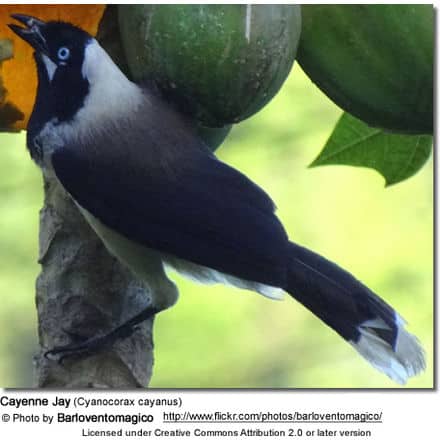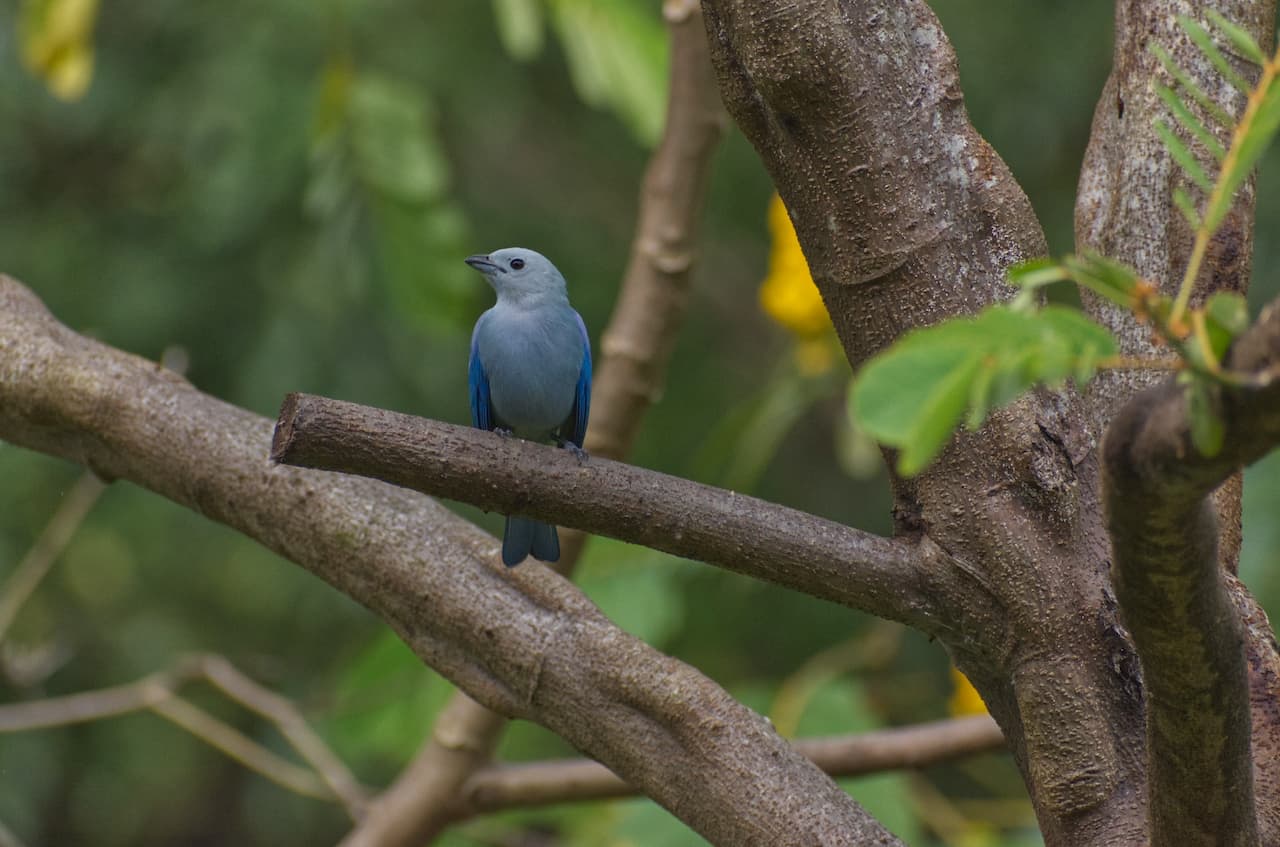Cayenne Jays
Jay Information … Photos of Different Jay Species for Identification
Overview … Alternate (Global) Names
Description … Calls / Vocalizations
Breeding / Nesting … Diet / Feeding
The Cayenne Jays (Cyanocorax cayanus) are medium-sized jays that naturally occur in northeastern parts of South America.
Distribution / Habitat
The natural range of the Cayenne Jays stretches from southeastern Venezuela (northern and eastern parts of the state of Bolívar and the southern regions of the state of Delta Amacuro), east to Guyana, the French Guiana, Suriname and south into northern Brazil, from the northernmost Brazilian state of Roraima south through the state of Amazonas to the city of Manaus near the lower Rio Negro river, and east through northern Pará to northern Amapá). Only a few records exist from Brazil, where they are very rare.
They are mostly found in humid lowland forests (in Venezuela up to an elevation of 3,600 feet / 1,100 meters), along the forest edges, heavily degraded former forests, wooded savannas, sandy soil regions, and dry shrubland. They are absent from continuous forests.
Description
Size
Length: Cayenne Jays measure between 12.2 – 13 inches (31 – 33 cm) in length – including the tail, which measures about 5.51 inches or 14 cm.
Wingspan: 5.9 – 7.5 inches (15 – 17 cm).
Length of bill: about 1.42 inches or 3.6 cm long.
Weight: Males average 6.17 oz (174.8 g) and females about 6.16 oz (174.6 g).
Plumage Details / Adults
The plumage is for the most part black, blue, and white.
Black: short frontal crest, forehead, the sides of the head, the throat, and the chest.
White/creamy white/bluish white: the rear crown and nape (back of the neck), lower chest, abdomen, and thighs. The tail is broadly tipped white. There is a small bluish-white or white spot above and below the eye. The malar (cheek) stripe is whitish.
Bluish-purple: Tail (except for the white tips) and wings.
Brownish purple: Back and “shoulders” (scapulars).
Other Physical Details
The eyes (irises) are white.
The bill is black.
Juvenile Description
Immature birds have a duller plumage. The white band at the tip of the tail is suffused with violet-yellowish-tan, particularly the central, long flight feathers of the tail (rectrices). The spots above and below the eyes are either smaller or absent. If present, these spots as well as the malar (“cheek”) stripes are more bluish than those of the adults.
Similar Species
- The White-tailed jays (found in Ecuador and Peru) can be identified by their mostly violet-blue, white-tipped tails and their mantle that is brown glossed with violet, brightest on the wings. Their moustache is slightly narrower and they have small white spots below the eyes.
- The Violaceous Jay (the only jay found in their range) lacks any facial markings or tail tips and has mostly blue plumage without any white markings.
- The White-naped Jay (Cyanocorax cyanopogon) of northeastern South America has a more extensive black crown and a smaller white nape spot. Also, the moustachial streak is blue instead of white. There is less white in the tail.
- The Azure-naped Jay has dark undersides (not white).
Diet / Feeding
Cayenne Jays feed on various insects (such as beetles and locusts), fruit, and berries.
Breeding / Nesting
In Venezuela, most breeding activities were observed between January and April, and in Suriname, nests were found in May.
The Cayenne Jays are described as communal / cooperative breeders that are usually found in family groups with at least three adult birds feeding the nestlings. The members of these small (family) groups have also been observed in mutual preening and they participate in mobbing predators in the vicinity of the nest.
The unlined, cup-shaped nests are constructed out of twigs and placed in the crown of tall trees.
A clutch consists of 3 – 4 eggs that are white with some brownish-greyish blotches. Each measured about 1.18 inches (29.9 mm) in length and 0.92 inches (23.4 mm) in width; and weighed about 0.3 oz (8.4 g).
Calls / Vocalizations / Sounds
Their most frequent calls are described as repetitive loud ringing “choh-choh-choh” or some variant thereof. They also make loud Keep Yop, melodius tjeeeooo, ringing kup-kup-kup, or harsh krait vocalizations.
Alternate (Global) Names
Chinese: ???? … Czech: Sojka guyanská … Danish: Cayenneblåskade … Dutch: Cayennegaaii … Estonian: Guajaana sininäär … Finnish: Orinoconnärhi … French: Geai de Cayenne … German: Cayenne Blaurabe, Weißbartblaurabe … Italian: Ghiandaia della Cayenna, Ghiandaia di Cayenne … Japanese: shirohararurisanjaku … Norwegian: Guyanaskrike … Polish: modrowronka bialoglowa, modrowronka bia?og?owa … Portuguese: gralha-azul , Gralha-da-guiana … Portuguese (Brazil): Gralha-azul, Gralha-da-guiana … Russian: ?????????? ???????????? ????? … Slovak: kapuciarka bielotylá, kapuciarka bielotylová … Spanish: Chara de Cayena, Piarro nuca blanca, Urraca de Nuca Blanca … Swedish: Cayennskrika
Species Research by Sibylle Johnson
Please Note: The articles or images on this page are the sole property of the authors or photographers. Please contact them directly with respect to any copyright or licensing questions. Thank you.






